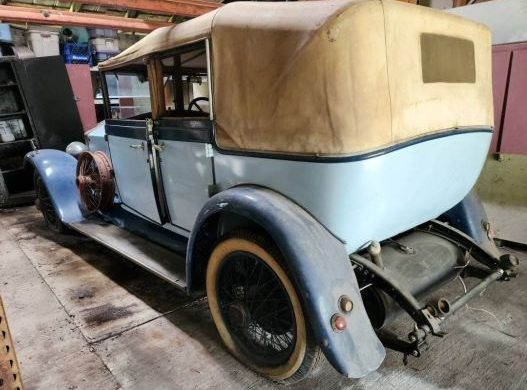UPDATE: This 1927 Rolls-Royce Twenty cabriolet is now at auction here on eBay, with bidding at $12,121, reserve met. Considering that no one was interested three weeks ago when the seller advertised the car on craigslist for $8000, he must be feeling pretty chipper right about now. This majestic old lady will head off to an enthusiastic new owner, and the seller will pocket more than planned. Have you ever sold a car for more than you expected? Let us know in the comments section.
FROM 8/2/2024: Rolls-Royce had a slight problem in the early 1900s: chauffeurs were becoming obsolete. Over in America, Henry Ford had produced the mechanically simple Model T – and folks from farmers to vacationers were driving them all over the country – without chauffeurs. Meanwhile, WWI would make finding personnel to take up driving and mechanical duties more difficult and expensive. Henry Royce sensed these trends, so in 1922 he introduced what would become known as the Baby Rolls – the Twenty. Utilizing a brand new detachable-head engine and constructed to a smaller scale than the contemporary Silver Ghost, the Baby Rolls was designed for owner/drivers.
It was simpler to drive and maintain, and despite an engine displacement half that of its sibling, it was capable of performing well. As was typical for prestige cars – Rolls, Bentley, Daimler – the customer received a chassis and chose a coachbuilder. We’ll see how despite the promise of the Twenty, the coachbuild process led Royce to build the 20/25 – a car that became a best-seller and saved Rolls-Royce from the worst effects of the Great Depression. Today’s Rolls Twenty is located in Oviedo, Florida, and the tip is courtesy of T.J.
The engine – along with the car’s steering, brakes, and suspension – were technologically advanced for the times. Coming in at 3.1 liters, the inline six-cylinder is estimated at 40 hp and top speed was at least 60 mph. The gearbox began as a three-speed manual with the gear lever in the center of the car, but by 1925, the new gearbox offered four speeds and the lever was situated on the right side – its traditional position. This car was partially restored by the seller’s late father, then parked for over thirty years. The engine received attention in the 1990s and was running then.
The interior was bypassed during the restoration process. The speedometer is missing from the gauge cluster, and the backs of the front seats are not shown in any of the photos provided. Someone has made a start on the wood trim, and the tan canvas top may be salvageable, but there’s still plenty to do in here. On the other hand, the underside is spiffier than I expected and shows evidence of renovation.
While Henry Royce produced a masterpiece in the Twenty, he was stymied by customers’ coachbuilders who could not give up building large, heavy bodies for the lithe chassis. Consequently, its performance attributes were stifled. This car’s body was built by Barker and Company, one of Rolls-Royce’s first and favorite builders – an alliance that began in 1905. However, Barker’s tendency to solve questions of strength by making its bodies heavier soured Rolls on Barker; they parted ways in the 1930s. If you’re not picky about coachbuilders, this 1927 Twenty is advertised here on craigslist for $8000. What’s the right price for a pre-war luxury cabriolet?






What a beast. In America, many of these types of cars were repurposed into tow trucks. US used Packards, Caddys and the like, I can only imagine Britain did that too. Whilst looking up RR tow trucks, a bloke from England wrote, “as a lad, I remember a garage in Holbeach, UK that had a repurposed 20s Rolls they used as a tow truck”. For good reason. Many times, these motors had more power than most trucks of the time, and I’d like to think showed the class of the tow operator, but more likely, it was just a junker they hauled in. Front reminds me of 50s era semis and love a 4 spoke steering wheel, about as much interest as a, well, I just don’t know, a 1927 Rolls Royce. Not bloody likely, on this side anyway. Imagine what a fantastic car this was going into the depression. While my cost conversions are subject to correction, one site says this car sold for almost $12,000, when the average yearly income was 1/10 that. Being a “cheapie” Rolls didn’t do anything and only about 3,000 of these were made. I just don’t know what will happen to these once ultra fantastic cars in the future.
Aye, they did; big old cars had no value – quite often because the body was rotten (it rains a lot here, in case you hadn’t heard…) – so small garages quite often had a Rolls or similar as a tow truck. Low cost and lots of torque. I have a photo of one in a book somewhere.
The comment of “Nick Harley” and the Phantom 1 truck he purchased from Walkers Garage, Holbeach, Lincolnshire in the 1960s is on PreWarCar dot com. A good read.
He provides before (oh was it ever a cobbled truck) and a pic of the car after restoration as a drop head coupe in 1969. Originally belonged to a sugar beet farming family.
Price might be in line, though…..body might look good, but what condition is the wood framing of the body? 60 mph? No way. 45 at best with a overdrive, which this looks to have. And not going up a hill! It is worth saving, but restoration costs are going to blow the bank, and as a 20, it needs to be a labor of love…trust me, been there, done that, loved every minute, and feel lucky to have broken even!
Days gone by